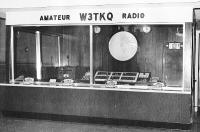Interest in operating mobile was growing rapidly at that time, just a few years after the end of World War II and the resumption of amateur radio activity, forbidden during the war years. War surplus radio equipment made it easy and inexpensive to get on the air. But the coincidental emergence of home television sets made it difficult to operate ham radio from a fixed location without the risk of television interference and an FCC citation. Many of the early Muntz, and other "gutless-wonder" TV receivers, straining to pick up a snowy Milton Berle on Philco's WPTZ, seemed almost equally responsive to harmonics from hams' unshielded--mostly home-brew--transmitters. Little wonder then, that many hams opted to avoid the problem by going mobile on six and ten meters.
Surplus transmitting crystals cut for 7 MHz, and mounted in FT-243 holders, were available for less then 50 apiece. One of these in a 6AG7 oscillator circuit, operating on the fourth harmonic and driving an 807 or 2E26 final, provided 25 or 30 watts on ten meters at minimal cost, and after only a few nights of bench time. A Gonset converter ahead of the car's broadcast radio provided reception. When Phil-Mont bought a quantity of crystals cut for 7373.333, and distributed them to members, our "net" frequency of 29,493 KHz was firmly established.
Walter Bradley Martin, W3QV, who by then had served a number of terms--before and after the war--as ARRL Atlantic Division Director, took many of the early Phil-Monters under his wing, showing them how to build, install and operate a rig. He also instilled in them the "service" aspect of our hobby. Brad, a Naval Reserve Captain who had served as Admiral Halsey's communications officer in the South Pacific, believed in and espoused the true meaning of the "PICON" clause in the federal communications act; it's that clause which justifies our very licensing in the "Public Interest, COnvenience and Necessity." W3QV monitored 29,493 day and night, and always responded immediately to any mobile--at any hour--with a friendly greeting and offer of assistance. Appropriately, our repeater system continues to sign his call today as a memorial to the significant role he played in Phil-Mont's early development and direction.
Phil-Mont developed diverse areas of service to the Delaware Valley community, providing communications support for boating races, model airplane meets, hot-air balloon flights, parades, marathons, bikeathons, hamfests, and in both simulated and actual emergency situations ranging from limited power failures to widespread floods. Phil-Mont members provided distinguished service along the Delaware River and in the Poconos during the devastating flood of August, 1955.
The club's alliance with civil defense and RACES occasioned moving the meeting place and club station to Philadelphia CD operating centers, first in West Philadelphia and later, about 1956, to the CD command post in Germantown Town Hall. Membership mushroomed to one hundred, when a ceiling at that level was established. A membership waiting list quickly grew, and eventually the ceiling was lifted by popular demand.
Frequent need for a mobile communications center resulted in the construction and outfitting of a trailer for on-site use in activities. As the state-of-the-art (and state-of-the-treasury) progressed, Phil-Mont--primarily through the efforts of W3QQH/W3BBB--subsequently designed and fully equipped a series of five "Mo-Com" units... first trailers, then a converted school bus, and finally a self-contained step-van truck, still in use by Abington Township.
With the advent of repeater technology, Phil-Mont was among the early groups in the nation to undertake repeater operation, initially on ten meters, then moving in the 60s to 147.03 MHz. It was also in the early 60s that the club moved its meeting place to The Franklin Institute Science Museum at the invitation of W. Laurence LePage, W3QCV, a Phil-Mont member and then vice president of the Institute. The club also assumed sponsorship of W3TKQ (now W3AA), the amateur radio demonstration station at the Institute, beginning a long and mutually beneficial relationship between the club and the Institute which continues today.
Phil-Mont conducts monthly general meetings at The Franklin Institute featuring programs of interest to members and welcome guests, monthly business meetings of the directors, and weekly information nets on both HF and VHF bands. In addition, the club continues to provide communications for special events, offers weekly on-the-air morse code practice, and conducts monthly license examination sessions. And in an extraordinary effort to promote amateur radio and the education of youth, a trained group of Phil-Monters voluntarily operate the W3AA exhibit station at The Franklin Institute seven days a week, explaining and demonstrating ham radio to the hundreds of visitors--many with school groups--who tour the museum every day.
The Phil-Mont Mobile Radio Club is understandably proud of its long and continuing tradition of service to the community and to amateur radio, one which rightfully earns its designation by the American Radio Relay League as a Special Services Club.
![]() Minutes of the first regular club meeting
Minutes of the first regular club meeting
 Amateur radio station
W3AA (originally W3TKQ) was
located from 1952 through 2002 at The Franklin
Institute Science Museum. Unfortunately, after 50
years of service in that location, museum
reconstruction forced relocation of the station,
which had been sponsored by PMRC since 1960.
Amateur radio station
W3AA (originally W3TKQ) was
located from 1952 through 2002 at The Franklin
Institute Science Museum. Unfortunately, after 50
years of service in that location, museum
reconstruction forced relocation of the station,
which had been sponsored by PMRC since 1960.
Read about W3AA/W3TKQ History here.
